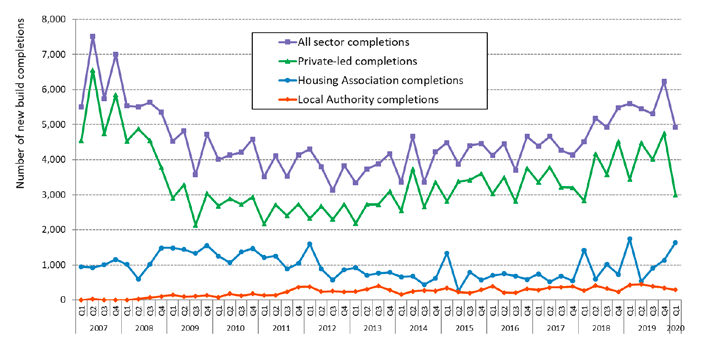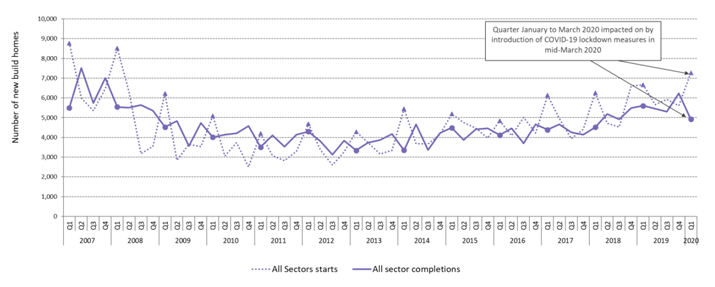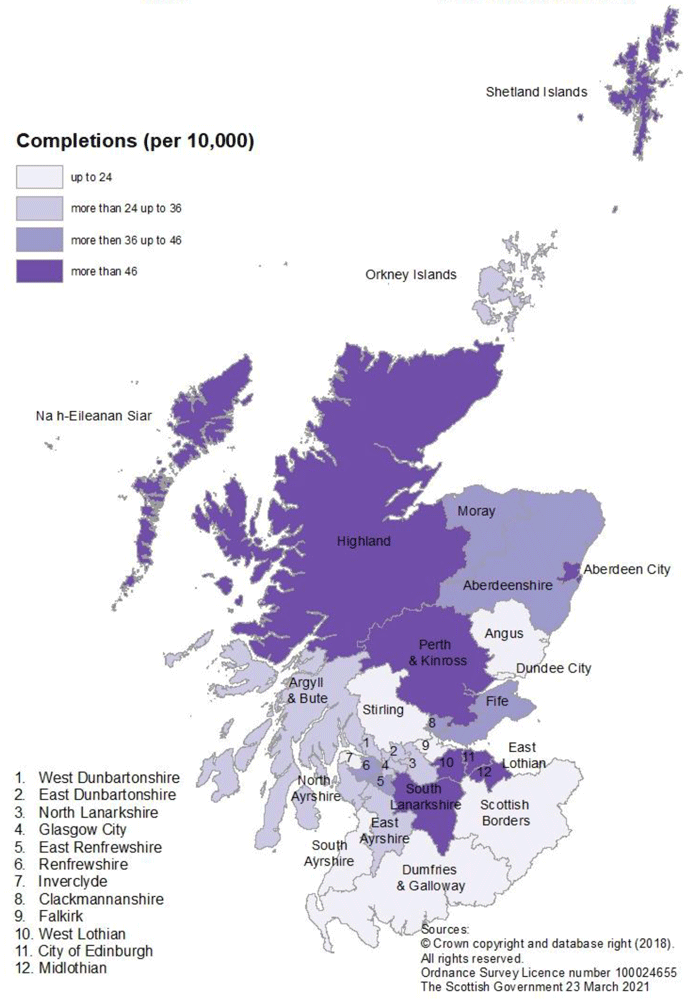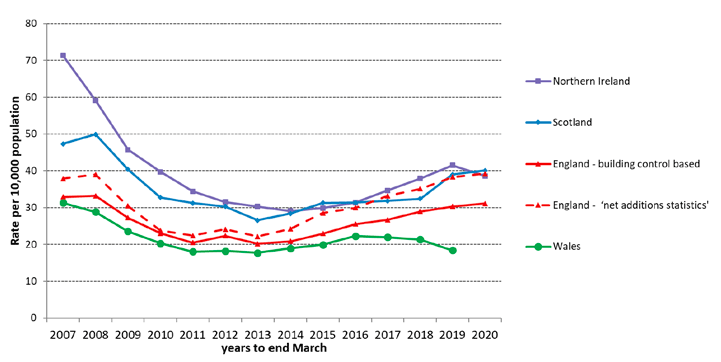Housing statistics quarterly update: March 2021
A summary of activity in new build housing and affordable housing in Scotland.
3. All-sector new housebuilding
The new-housebuilding section of this document provides figures on the number of homes started (when the foundations are begun) and completed (when a building inspector deems the property complete).
Figures are presented for homes built on privately led (referred to throughout as private sector), local authority led (referred to as local authority sector) and housing association led (referred to as housing association sector) sites. Social sector housebuilding is the combined total of local authority and housing association builds.
For the private sector the latest information available is for the quarter ending March 2020. Therefore headline findings for new housebuilding across all sectors are presented up to end March 2020, with other figures on social sector housebuilding presented up to end June 2020 where more recent data allows.
The figures have not been seasonally adjusted and so commentary tends to compare the latest 12 month period with the previous 12 month period, or the latest quarter with the same quarter in the previous year. To help with this, Quarter 1 figures (from January to March) have been highlighted in the charts to allow easy comparison over time. Some of the peaks in the number of starts in Quarter 1 each year are due to large numbers of housing association approvals being granted near the end of the financial year.
It should be noted that the amount of all-sector new housebuilding activity recorded in the quarter January to March 2020 will have been impacted to some extent by the introduction of government advice and measures to reduce the spread of the coronavirus (COVID-19) from mid-March onwards, in which non-essential construction activity stopped, and home buyers were advised to delay moving to a new home where possible. These impacts towards the end of this quarter will have lowered the total amount of activity recorded compared to what would otherwise have been the case. Year to date totals to end March 2020 will also have been affected.
Chart 1 shows that annual all-sector new build starts and completions (years to end March) have both shown a broadly increasing trend since 2013. In the latest year, starts and completions have increased by 9% and 3% respectively, despite activity levels being affected by the start of COVID lockdown measures in the final month of this annual period. Future published figures for the quarter April to June 2020 are likely to be impacted to a greater extent given the continuation of lockdown measures over most of this quarter until late June 2020.
Figures for the year to end March 2020
There were 4,917 all sector new build homes completed between January and March 2020; a 12% decrease (686 homes) on the same quarter in 2019 but 9% more (406 homes) than the same quarter in 2018. This brings the total for the year to end March 2020 to 21,910, up 3% (722 homes) compared to the 21,188 completed in the previous year and the highest annual figure to end March since 2008.
There were 7,268 new build homes started between January and March 2020, 9% more (602 homes) than the same quarter in 2019. This brings the total for the year to end March 2020 to 24,458 which is up 9% (1,954 homes) compared to the 22,504 homes started in the previous year.
| Starts | Completions | |
|---|---|---|
| Quarter Jan to Mar 2018 | 6,260 | 4,511 |
| Quarter Jan to Mar 2019 | 6,666 | 5,603 |
| Quarter Jan to Mar 2020 | 7,268 | 4,917 |
| Change from Q1 2019 to Q1 2020 | +602 | -686 |
| Change from 2019 to 2020 (%) | +9% | -12% |
| Year to Mar 2018 | 19,754 | 17,571 |
| Year to Mar 2019 | 22,504 | 21,188 |
| Year to Mar 2020 | 24,458 | 21,910 |
| Change from 2019 to 2020 | +1,954 | +722 |
| Change from 2019 to 2020 (%) | +9% | +3% |
Trends since 2007
Chart 2 below presents new build completion trends on a quarterly basis and by sector. This shows the impact of the recession in the second half of the last decade, with private sector led completions falling throughout 2008 due to the financial crisis. Following this, private led completions decreased more gradually until 2013 and have been broadly increasing in more recent years, although levels of activity in the most recent quarter January to March 2020 will have been affected by the start of COVID-19 lockdown measures in mid-March onwards.

Chart 3 shows quarterly trends in all-sector starts and completions, which are generally both showing an upwards trend since 2014. However in the latest quarter from January to March 2020, there will have been some impact from the introduction of COVID-19 lockdown restrictions on the all-sector starts and completions activity.

Sub-national local authority figures for the year to end March 2020
The information on new build housing in Scotland is collected and published at local authority level. Map A, below, shows new house building in the year to end March 2020, as a rate per 10,000 population based on the latest mid-2019 population estimates.
In the year to end March 2020 the highest new build rates were observed in East Lothian Midlothian, Perth & Kinross, West Lothian and Edinburgh. The lowest rates were observed in Stirling, Inverclyde, Dundee City and Dumfries & Galloway.

Comparison with the rest of the UK from 2007 to 2020
Each of the countries of the UK produces their own statistics on quarterly new build housing starts and completions by tenure, and all use broadly consistent definitions. These new build statistics for each of the countries of the UK can be found on the UK House building update to October to December 2019 section of the ONS website.
In addition to this, the Ministry of Housing, Communities and Local Government (MHCLG) also produces an additional annual set of statistics for England on new build homes, as a component part of the 'Housing supply; net additional dwellings, England' set of statistics[1]. These statistics are collected on a different basis to the quarterly UK country statistics as local authorities can use a range of data sources to collate these figures, rather than solely using building control information. Figures on this for 2019/20 were published in November 2020, and the publication advised that the 'net additional dwellings' should be considered the primary and most comprehensive measure of housing supply in England.
MHCLG have advised that the quarterly new build statistical collection for England, whilst being a useful leading indicator of activity throughout the year, is not currently capturing all new build activity. This is largely due to difficulties in collecting accurate starts and completions data from independent building inspectors or where building control has been sourced out to strategic partnerships or the private sector. These data issues do not exist in the Scotland quarterly housing statistics, given that all of the 32 local authorities in Scotland directly manage building control and the associated provision of data to the Scottish Government on starts and completions.
As a result of this advice from MHCLG, the new build component figures of the 'net additional dwellings' statistics for England are included in the UK comparisons as an additional set of figures to consider when comparing between countries.
Chart 4 presents trends in the rates of new house building per 10,000 population across each of the UK countries (years to end March). The latest available Ministry of Housing, Communities and Local Government (MHCLG) annual 'net additional dwelling' statistics for England indicate that whilst Scotland had a higher rate of completions per 10,000 head of population than England over the period 2007 to 2015, both have seen broadly similar rates of housebuilding each year across the period 2016 to 2020, when comparing the Scotland figures to the England net addition figures.
In the latest year, the 40 homes built per 10,000 population in Scotland is similar to the rates seen in England and Northern Ireland (both 39 homes per 10,000). The new housebuilding figures for Wales are yet to be published but will be added to Chart 4 in future publications when available.

Contact
Email: housingstatistics@gov.scot
There is a problem
Thanks for your feedback